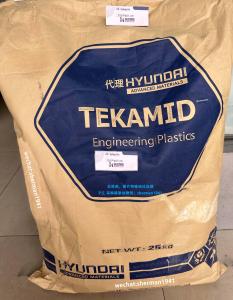PA6 TB130GM Hyundai
| 品牌 | Hyundai |
|---|---|
| 货号 | 面议 |
| 牌号 | PA6 TB130GM Hyundai |
| 型号 | PA6 TB130GM Hyundai |
| 品名 | PA6 |
| 外形尺寸 | 25kg/包 |
| 产品用途 | 汽车应用 |
| 生产企业 | Hyundai |
17年专注工程塑料
生产,销售,技术一条龙服务广泛应用于电子,电器,通讯设备,汽车制造,航空航天,玩具,生活日用品等行业
不仅仅只是一次买卖——万物皆以延续而存在
网址:www shermancn com (公司内部物性查询正在建立中... 敬请期待)
PA66;别名尼龙66;聚己二酰己二胺,是一种热塑性树脂,一般是由己二酸和己二胺缩聚制的。
PA的品种很多,主要有PA6、PA66、PA610、PA11、PA12、PA1010、PA612、PA46、PA6T、PA9T、MXD-6芳香醯胺等。以PA6、PA66、PA610、PA11、PA12最为常用。
PA66特性
PA66塑料在聚酰胺材料中有较高的熔点。它是一种半晶体-晶体材料。PA66在较高温度也能保持较强的强度和刚度。
PA66塑料在成型后仍然具有吸湿性,其程度主要取决于材料的组成、壁厚以及环境条件。在产品设计时,一定要考虑吸湿性对几何稳定性的影响。
PA66塑料的粘性较低,因此流动性很好(但不如PA6)。这个性质可以用来加工很薄的元件。它的粘度对温度变化很敏感。
PA66的收缩率在1%~2%之间,加入玻璃纤维添加剂可以将收缩率降低到0.2%~1% 。收缩率在流程方向和与流程方向相垂直方向上的相异是较大的。
PA66塑料热性质熔点即结晶熔解时的温度,对结晶性高分子PA66塑料,显示清晰的熔点,根据采用的测试方法,熔点在259~267℃的范围内波动。通常采用差热分析法测出的PA66塑料的熔点为264℃。如果将体积膨胀系数显示极大值的温度当作熔点,则尼龙-66的熔点温度范围为246~263℃。接近理论熔解温度259℃。
PA66塑料的注塑特性干燥处理:如果加工前材料是密封的,那么就没有必要干燥。然而,如果储存容器被打开,那么建议在85℃的热空气中干燥处理。如果湿度大于0.2%,还需要进行105℃,12小时的真空干燥。
PA66主要用于汽车工业,电气电子工业,交通运输业,机械制造工业,电线电缆通讯业,薄膜及日常用品.制造各种轴承,齿轮,圆齿轮、凸轮、伞齿轮、输油管,储油器,保护罩,支撑架,车轮罩盖,导流板,风扇,空气过滤器外壳,散热器水室,制动管,发动机罩,车门把手.轴承、齿轮、滑轮泵叶轮、叶片、高压密封圈、垫、阀座、衬套、输油管、贮油器、绳索、传动带、砂轮胶粘剂、电池箱、电器线圈、电缆接头各种滚子、滑轮、泵叶轮、风扇叶片、蜗轮、推进器、螺钉、螺母、耐油密封垫片、耐油容器、外壳、软管、电缆护套、剪切机、滑轮套、牛头刨床滑块、、电磁分配阀座、冷陈设备、衬垫、轴承保持架、汽车和拖拉机上各种输油管、活塞、绳索、传动皮带,纺织机械工业设备零雾料,以及日用品和包装薄膜等。还有包装用带、食品用薄膜(熟食用的高温薄膜和清凉饮料用的低温薄膜)的产量也相当大。
Nylon 66 (loosely written nylon 6-6, nylon 6/6, nylon 6,6, or nylon 6:6) is a type of polyamide or nylon. It, and nylon 6, are the two most common for textile and plastic industries. Nylon 66 is made of two monomers each containing 6 carbon atoms, hexamethylenediamine and adipic acid, which give nylon 66 its name.Aside from its superior physical characteristics, nylon 66 is attractive because its precursors are inexpensive.
Synthesis and manufacturing
Hexamethylenediamine (top) and adipic acid (bottom), monomers used for polycondensation of Nylon 66.
Nylon 66 is synthesized by polycondensation of hexamethylenediamine and adipic acid. Equivalent amounts of hexamethylenediamine and adipic acid are combined in water. In the original implementation, the resulting ammonium/carboxylate salt was isolated and then heated either in batches or continuously to induce polycondensation.
n(HOOC?(CH2)4?COOH)+n(H2N?(CH2)6?NH2)?[?OC?(CH2)4?CO?NH?(CH2)6?NH?]n+(2n?1)H2O
Removing water drives the reaction toward polymerization through the formation of amide bonds from the acid and amine functions. Alternatively, the polymerization is conducted on a concentrated aqueous mixture formed of hexamethylenediamine and adipic acid.
It can either be extruded and granulated at this point or directly spun into fibers by extrusion through a spinneret (a small metal plate with fine holes) and cooling to form filaments.
Applications
In 2011 worldwide production was two million tons. At that time, fibers consumed just over half of production and engineering resins the rest. It is not used in film applications as it cannot be biaxially oriented. Fiber markets represented 55% of the 2010 demand with engineering thermoplastics being the remainder.
Nylon 66 is frequently used when high mechanical strength, rigidity, good stability under heat and/or chemical resistance are required.It is used in fibers for textiles and carpets and molded parts. For textiles, fibers are sold under various brands, for example Nilit brands or the Cordura brand for luggage, but it is also used in airbags, apparel, and for carpet fibres under the Ultron brand. Nylon 66 lends itself well to make 3D structural objects, mostly by injection molding. It has broad use in automotive applications; these include "under the hood" parts such as radiator end tanks, rocker covers, air intake manifolds, and oil pans,as well as numerous other structural parts such as hinges,[8] and ball bearing cages. Other applications include electro-insulating elements, pipes, profiles, various machine parts, zip ties, conveyor belts, hoses, polymer-framed weapons, and the outer layer of turnout blankets.[9] Nylon 66 is also a popular guitar nut material.
Nylon 66, especially glass fiber reinforced grades, can be effectively fire retardant with halogen-free products. Phosphorus-based flame retardant systems are used in these fire-safe polymers and are based on aluminium diethyl phosphinate and synergists. They are designed to meet UL 94 flammability tests as well as Glow Wire Ignition Tests (GWIT), Glow Wire Flammability Test (GWFI) and Comparative Tracking Index (CTI). Its main applications are in the electrical and electronics (E&E) industry.


